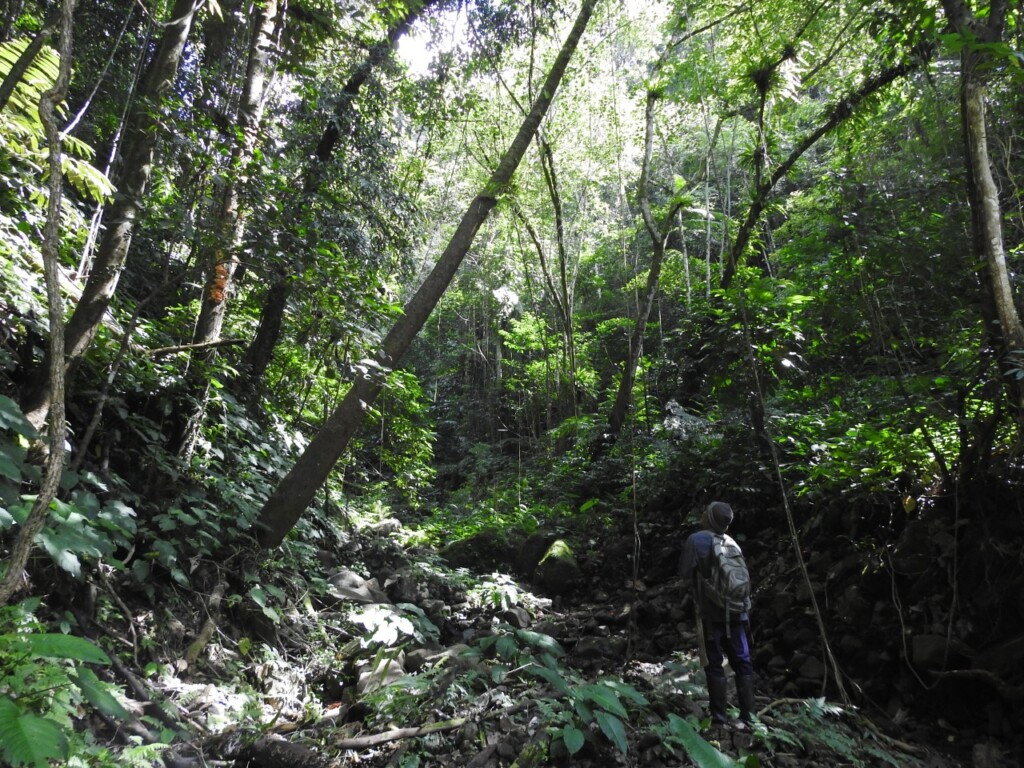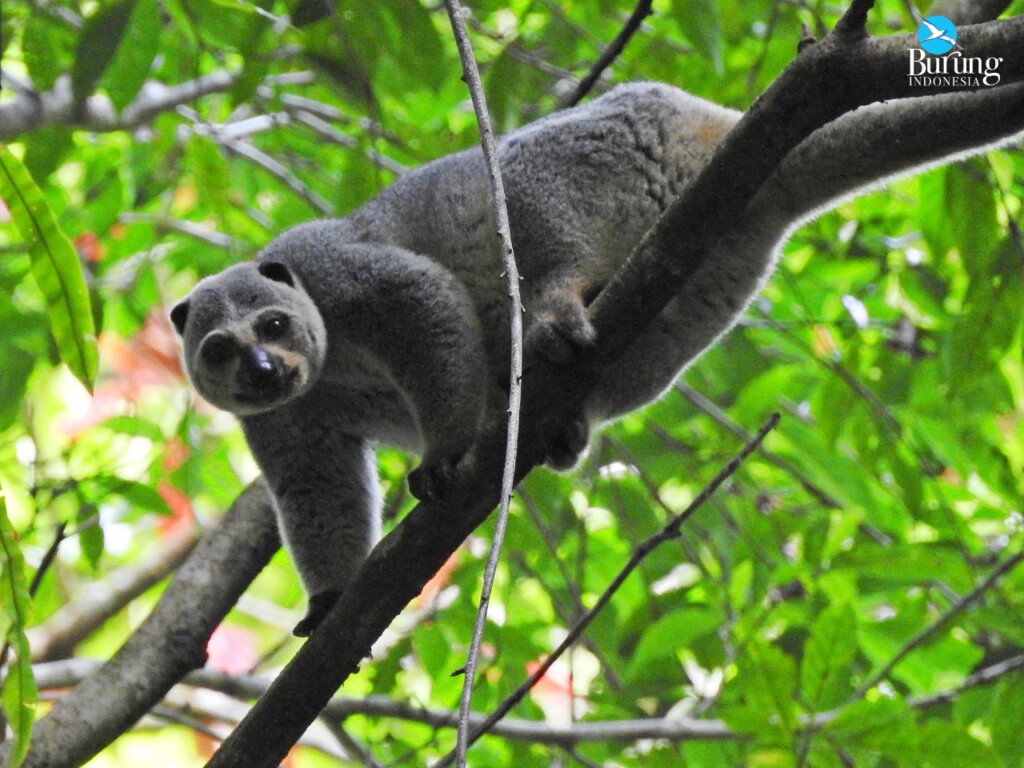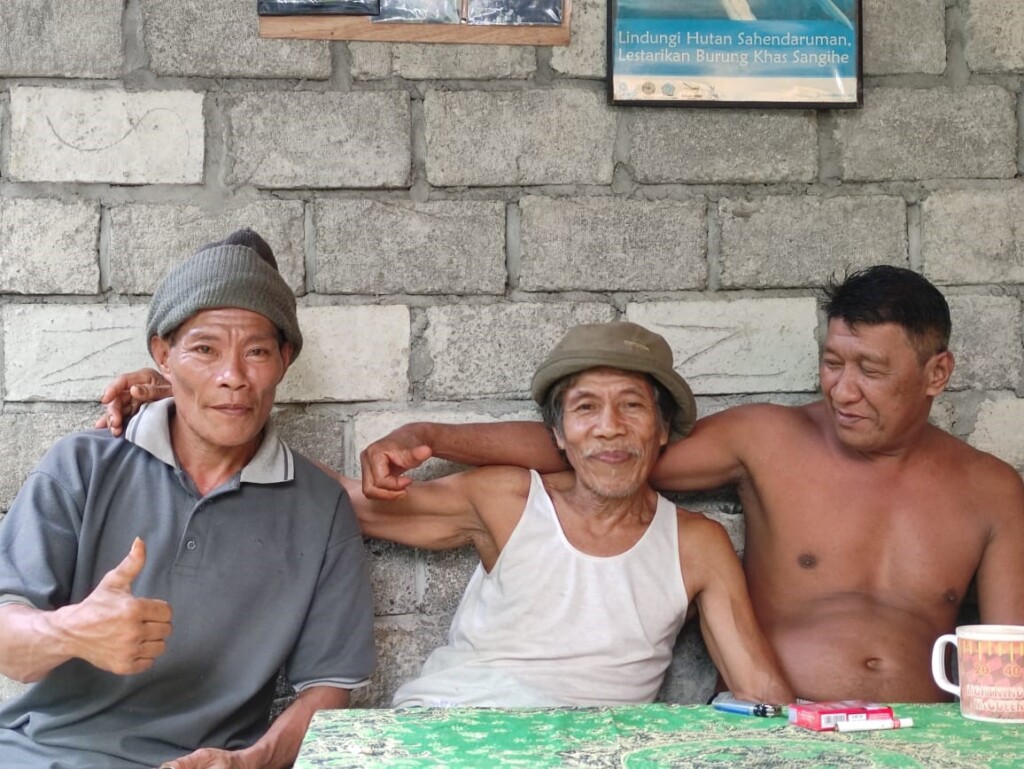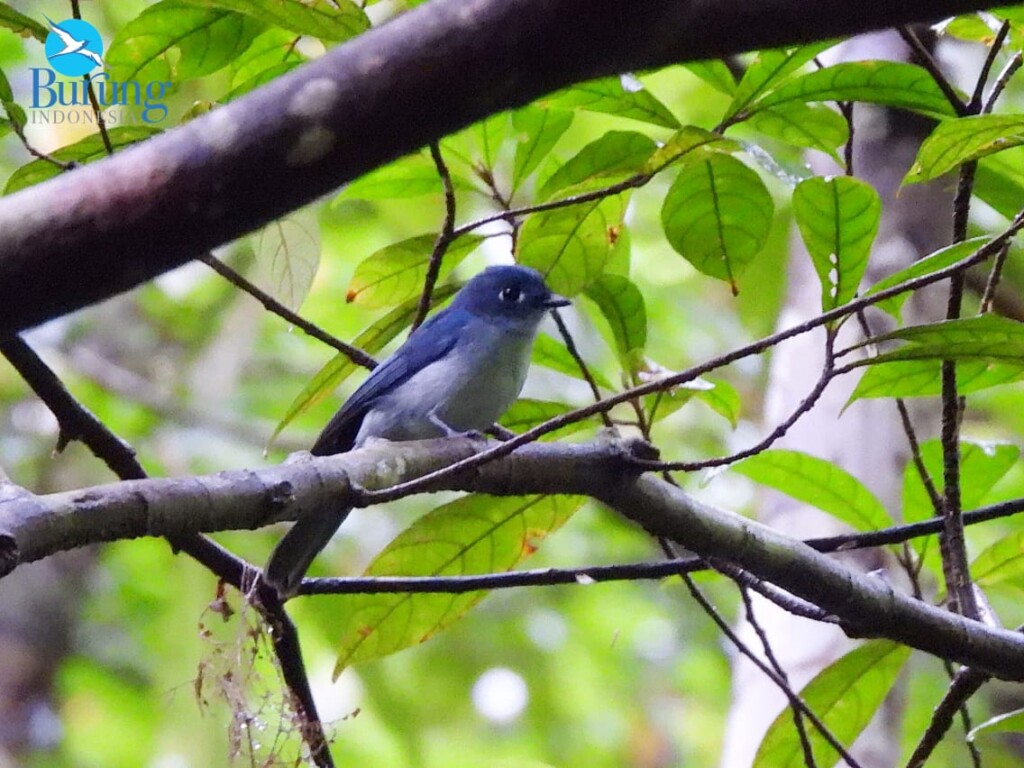
Birdwatchers know Anius Dadoali by the name Bu’ Niu (bu’ is Sangirese for ‘uncle’). The locals in the village of Ulung Peliang and the surrounding area also often refer to him as Burung, which means bird in Indonesian. Born 57 years ago in Ulung Peliang Village, Sangihe Islands Regency in North Sulawesi Province, Bu' Niu is the Ara - as the Sangihe people call the middle child - of ten siblings. He spent his childhood in the fields and forests, like most other village children.
In the forest, Bu' Niu set snares for pigs, hunted and collected forest products such as rattan and wood, following in the footsteps of her father, a renowned bamboo blowpipe hunter who knew all the trails in the forest behind their house-the Mount Sahendaruman forest. He often asked his father about many things - animals, plants, names of places, and myths believed by the people in the area. Bu' Niu's habit of hunting and gathering the products of the forest when he was a young man later led him to be knowledgeable about many things about Sahendaruman and its surroundings.
Bu' Niu married a woman from Kulur village and went through a courtship period that may not be common among young people today. To visit, Bu' Niu must set off in the early morning darkness, following the Sahendaruman forest path to Kulur village, which borders Ulung Peliang village at the top of Sahengbalira. When returning home, if he didn't have a torch with him, he used the light from the phosphorescent fungi found in the forest. He collected mushrooms until there were enough to give him light. He also carried a stick as a tool to use if needed during the journey. During his night walks, he often encountered many animals, including the Kuse, the local name for the Talaud Bear Cuscus (Ailurops melanotis). Kuse was one of the animals he once kept, along with the Small Sulawesi Cuscus (Strigocuscus celebensis) and the Kalea, or Blue-backed Parrot (Tanygnathus sumatranus). The three species are now rarely seen, especially the Kalea, which is thought to have disappeared from the forests of Sahendaruman.
Bu' Niu then became involved in research when he accompanied Jon Riley and Jim Wardill, who were doing their Masters, in search of a bird that had been thought extinct for 100 years: the Cerulean Flycatcher (Eutrichomyias rowleyi). Prior to Sahendaruman, the two young researchers had spent years searching for the bird on Mount Awu, North Tabukan, but to no avail. Hypothesizing animal migration, they shifted their search to Mount Sahendaruman in the south, as Mount Awu had erupted several times and the animals there might have moved elsewhere.
The two then visited villages around Sahendaruman and showed the sketches and characteristics of the Cerulean Flycatcher to the community. Since no one recognized the bird, Riley and Wardill decided to survey the Sahendaruman forest area through Ulung Peliang village. They also offered opportunities to villagers who wanted to help clear trails and carry supplies. Initially, the community refused due to language barriers or fear of being deceived by the two foreigners, but eventually Bu' Niu and several others ventured to participate as porters for IDR 30,000 per day.

The search for the Cerulean Flycatcher continued for years on the observation trails in the valleys and ridges of the Sahendaruman forests, but the results remained nil, even though the project's deadline and the declaration of the bird's total extinction were only two weeks away. At that time, the research team established a base camp in Kalumelahana, in a house owned by Bu' Eping, the youngest sister of Bu' Niu's father. The house now serves as a base camp when researchers or wildlife observers conduct research in the Ulung Peliang forest area. In the afternoon, after Bu' Niu finished making the machete, he went to check on the Kalumelanana post. As usual, he tidied up the area and waited at base camp; it turned out that Riley, Wardill, and the others still hadn't come home. Seeing that the pot was empty, he decided to walk down to the valley of Mount Sahengbalira to fetch water. Sahengbalira means "machete back" because the ridge is thin and long, with steep ravines on either side.
Around 5:00 p.m., while filling the pot, Bu' Niu looked around and saw a small blue bird flying and perched above her. He noticed about five of the same birds fluttering about. Before returning to base camp, he wondered if these were the birds Riley and Wardill were looking for. Bu' Niu boiled the water he had brought and waited a long time, but no one came to the base camp. He decided to go home first, prepare several sets of clothes, and tell his father that he would be staying overnight with the researchers.

When he arrived at base camp that night, he immediately asked Yoris, the interpreter, about the characteristics of the bird they were looking for. After Yoris showed him the field guide and the illustrations in it, Bu' Niu was convinced that the birds he saw when he fetched water were Cerulian Flycatchers, and they discussed it excitedly. Riley, who had been watching them, asked, and after joking around for a while Yoris finally told him that Bu' Niu claimed to have seen the bird they were looking for.
Unable to sleep at the thought, Riley asked Yoris and the others to check, and it was true that there was a Cerulian Flycatcher at the location. After that being confirmed, Riley rushed to the location and saw several Cerulian Flycatches flying. He unconciously shed tears and leaned against a tree trunk. Riley and Wardill, who had finally found the Cerulian Flycatcher after so many years, cried tears of joy.
Bu' Niu's New Life
After the event, they returned to the village to report the bird's discovery. Riley and Willard conducted a survey to find out its local name, but even Bu’ Niu’s father, the famous hunter who grew up in the forest, could not identify it. Since no one knows, as a tribute and marker, the name Niu is given to the local name Cerulean Flycatcher. After that, an intensive survey was carried out again. The Cerulean Flycatcher has become easier to find in the Sahendaruman valleys where it was not found before. As explorers became frequent visitors to the rest house, Bu'Niu's father was astonished and decided to retire from hunting. He gave all his hunting tools to his family and people who asked for them, until there were none left.
Riley and Wardil's research was extended by the discovery of the Cerulean Flycatcher. To get more data, they tried to catch the birds with a mist net, but not a single bird was caught after several days of setting up the net. Bu' Niu also tried and failed several times because this bird can maneuver very quickly. Finally, Mrs. Niu took two wooden blocks and waited for the Cerulean Flycatcher to land near the net. When they were close enough, Bu' Niu banged the blocks together as fast and as hard as he could until they made a loud noise, causing the shocked bird to fly and get caught in the net. After taking body measurements and a DNA sample, Riley asked to use the bird as a specimen and bring it to the museum, but Mrs. Niu refused because the sex was not yet known. He said that it could be the last male or the last female of the species, so making it into a specimen could lead to its extinction in nature. Upon hearing this, Riley released the bird.
He said that it could be the last male or the last female of the species, so making it into a specimen could lead to its extinction in nature. Upon hearing this, Riley released the bird.
After Riley and Wardill's study was completed, Bu' Niu became a guide for researchers or individuals who wanted to observe the Cerulean Flycatcher. His experience of studying with strangers has given him a wealth of knowledge about simple data collection methods, whether it be wildlife data or vegetation analysis. Together with his friend Weasley Pangimangen from Lelipang village, he collected the vocalization data of every bird in Sahendaruman several times using a voice recorder and observed the valleys in Mount Sahendaruman. Out of 48 valleys, only 23 were confirmed to be the habitat of the Cerulean Flycatcher. He has often experienced the bitter-sweet experience of accompanying researchers with different characteristics and personalities during surveys.
Slowly but surely, he began to realize the benefits of being a guide after all this time. Since it is not a permanent job, he understands that his income as a guide is not much, but at least it provides a glimmer of hope that the Cerulean Flycatcher and Sahendaruman where he used to play will be preserved. He sometimes takes their children with him when he works, hoping that they will continue his efforts to protect Sahendaruman in the future.

Besides being a guide, Bu' Niu's main job is farming, but he also raises chickens and fish and does whatever else he can. Bu' Niu grows nutmeg, cloves, taro, bananas, coconuts, and other cash crops. Part of Bu' Niu's garden borders the protected forest area of Mount Sahendaruman, but the actual garden inside the area is much larger. His family's gardens inside the forest have long been abandoned and unmaintained. He has wholeheartedly allowed his garden to become forest again. There's a reason for this. If these gardens are cultivated, sooner or later the water will run out, and the gardens and other gardens underneath them will have no source of water. So he decided to leave the gardens inside the protected areas as forests to support many gardens and the lives of people in his village. In this way, the area for the Cerulean Flycatcher's habitat will be larger.
Mt. Sahendaruman Protected Forest was designated as a protected forest with an area of 3,549 hectares by MenHutBun Decree No. 452/KPTS-II/1999 dated June 17, 1999. The mountain itself is the center of biodiversity on Sangihe Island, home to a wide variety of endemic flora and fauna whose livelihoods depend on the remaining native forests. There are about 30 villages in five districts that are in direct contact with the Sahendaruman forest area. Bu' Niu is a member of Elung Banua (forest conservationist) and KPA (nature conservation group) in Kampung Ulung Peliang. Despite his limitations, he occasionally shares conservation messages with friends from different backgrounds, especially about catching and hunting animals. According to him, hunting is allowed, but only for species classified as pests, not for species that are already rare in nature. Because nature creates something for humans, use it wisely, not exploitatively. It is this message that he conveys to his children, siblings, young people, even fellow parents when they gather, whether they are sober or half drunk. (Ganjar C. Aprianto)


